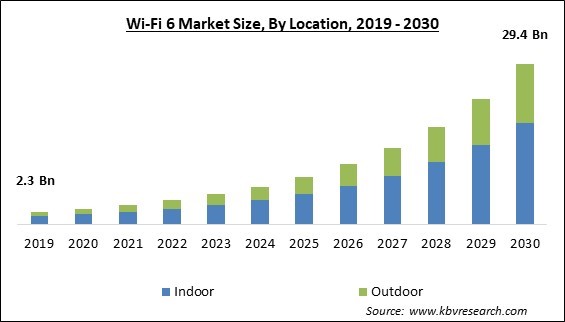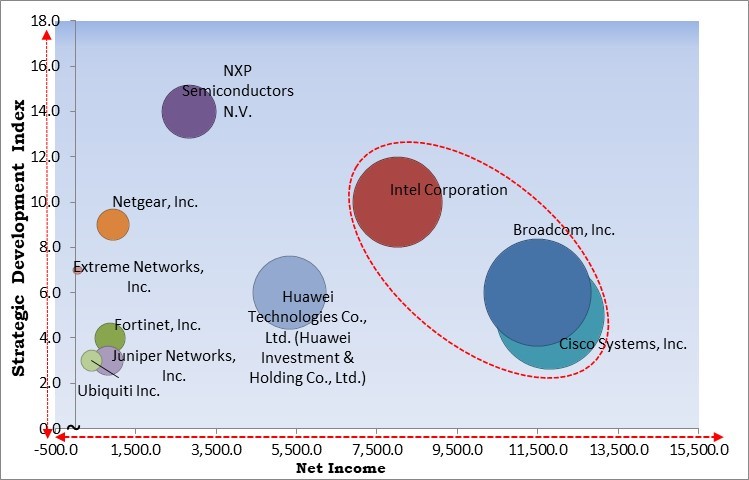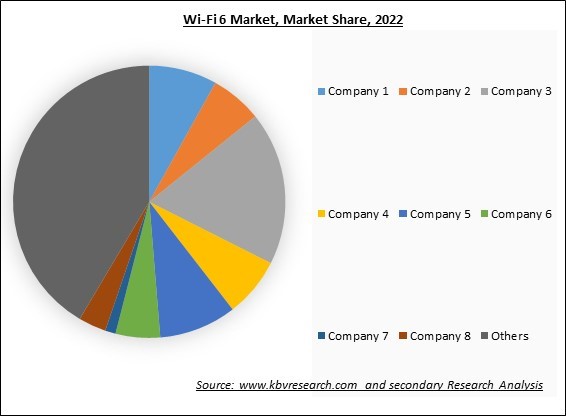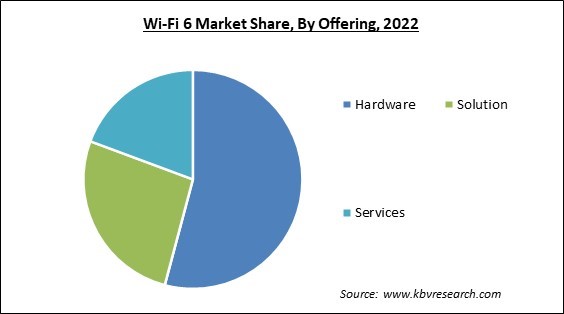The Global Wi-Fi 6 Market size is expected to reach $29.4 billion by 2030, rising at a market growth of 26.9% CAGR during the forecast period.
The educational sector will likely experience a greater influx of new wireless devices than any other industry. Consequently, the education segment is anticipated to capture approximately 1/4th share of the market by 2030. As students return to schools, colleges, and universities, institutions must be prepared to manage hundreds or thousands of new devices in addition to legacy devices. Wi-Fi 6 can greatly enhance indoor and outdoor Wi-Fi performance, which benefits schools that want to provide excellent wireless connections. With the advent of eLearning and online exam practices, there has been a rise in demand for dependable and secure Internet access. Staff members and students can access the internet from various devices and locations due to Wi-Fi 6 solutions and services. Moreover, Wi-Fi 6 accommodates the growing connectivity requirements of learning activities, online education, and business operations.

The major strategies followed by the market participants are Product Launches as the key developmental strategy in order to keep pace with the changing demands of end users. For instance, In January, 2022, Ubiquiti rolled out The new UniFi Wi-Fi 6 Pro access point and is the most capable suite packed within much of a similar design. In October, 2022, NXP Semiconductors introduced the OrangeBox, an automotive-grade development platform that combines a broad range of NXP wireless technologies, including broadcast radio, Wi-Fi 6, and Bluetooth.
Based on the Analysis presented in the KBV Cardinal matrix; Cisco Systems, Inc., Broadcom, Inc., and Intel Corporation are the forerunners in the Market. In January, 2022, Intel launched 12th Gen Intel® Core™ mobile processors with combined Wi-Fi 6/6E abilities. The launch aims to enhance its competitive edge and Intel's position in the gaming market. Companies such as NXP Semiconductors N.V., Netgear, Inc. and Huawei Technologies Co., Ltd. are some of the key innovators in the Market.

Increasingly, digital transformation is propelled by drastically changing user expectations. Most industry verticals, such as BFSI, healthcare, and retail, are transforming digitally. This has led to a rise in the adoption of Wi-Fi 6 technology across industries, enabling companies to decrease the cost of connection installation, which entails physically laying out wired connections. In addition, the increasing prevalence of e-learning in schools and universities requires a unified network connection to ensure uninterrupted service. As a result, it is expected that the expansion of all these sectors will offer the market significant growth prospects over the forecast period.
The Internet's expanding impact on individual consumers and large economies has become an increasingly crucial aspect of day-to-day lives. The International Telecommunication Union (ITU) estimated that in 2022 there were approximately 5.3 billion Internet users globally. It indicates that a sizable portion of the world's population is connected to the World Wide Web (www), presenting lucrative prospects for the market. These Wi-Fi 6 frames also help to reduce network interference from other networks and increase network speed. Consequently, the demand for Wi-Fi 6 technologies will increase in the residential, commercial, and industrial areas. All these factors are propelling the growth of the market.
The Wi-Fi 6 technology provided by smartphones, computing devices, routers, and other smart products is expensive and unavailable for mid-range products. Wi-Fi 6 devices are being made for a particular niche, and it will take a few years to displace Wi-Fi 5 devices. In addition, users will need a gigabit-class broadband connection to utilize Wi-Fi 6 technology fully. However, vendors of Wi-Fi 6 devices are now focusing on product expansion and design improvements to meet market demand and make it accessible to all. Since Wi-Fi 5 devices are widely used and readily available, they are limiting the market growth for Wi-Fi 6 in the current scenario.

The leading players in the market are competing with diverse innovative offerings to remain competitive in the market. The above illustration shows the percentage of revenue shared by some of the leading companies in the market. The leading players of the market are adopting various strategies in order to cater demand coming from the different industries. The key developmental strategies in the market are Product Launches and Product Expansions.
Based on offering, the market is segmented into hardware, solution, and services. In 2022, the hardware segment held the highest revenue share in the market. Wi-Fi 6 relies more on hardware than software updates, so any performance enhancements require new hardware. Wi-Fi 6 requires a compatible router for support, and most manufacturers have already begun producing routers with Wi-Fi 6 capability. This is anticipated to aid in the segment's revenue growth.

On the basis of location, the market is fragmented into indoor and outdoor. In 2022, the outdoor segment acquired a substantial revenue share in the market. The new Wi-Fi 6 access points improve performance and efficiency beyond 802.11ac networks, even without 802.11ax hardware. The rapid adoption of Wi-Fi 6 enables organizations to support a greater number of concurrent users and devices and deliver more simultaneous video streams than previously. Wi-Fi 6 technology is used by expert antennas with high-power amplifiers to provide robust and wide wireless coverage to a range of outdoor sites. Maximum ranges for 2.4 and 5 GHz are 200 and 300 meters, respectively. Due to these factors, the segment's revenue is expected to increase during the projected period.
The hardware segment is further subdivided into wireless access points, mesh routers & home gateways, wireless controllers, system on chip, and others. The wireless access points segment procured the highest revenue share in the market in 2022. Wireless Access Points (WAPs) that support Wi-Fi 6, also known as 802.11ax, offer significant improvements in terms of speed, capacity, and performance compared to earlier Wi-Fi standards. Wi-Fi 6 includes WPA3 encryption as the default security protocol, offering stronger protection against unauthorized access and security breaches. These advantages make Wi-Fi 6 access points highly desirable for both home and enterprise wireless networking environments.
By application, the market is segmented into immersive technologies, HD video streaming & video streaming, smart home devices & telemedicine, IoT, Industry 4.0, public wi-fi & dense environments, and others. The IoT, Industry 4.0, public Wi-Fi and dense environments segment garnered a significant revenue share in the market in 2022. Industry 4.0 environments frequently involve various connected devices, including sensors, robots, machinery, and Internet of Things (IoT) devices. High device density environments are suited for Wi-Fi 6 due to their increased capacity and handling of concurrent connections. Wi-Fi 6 provides faster data transmission rates, which is beneficial for transmitting large amounts of data generated by sensors, cameras, and other smart devices in smart manufacturing facilities and factories.
Based on vertical, the market is divided into retail & e-commerce, government & public sector, manufacturing, media & entertainment, healthcare & life sciences, transportation & logistics, travel & hospitality, education, residential, and others. The healthcare and life sciences segment procured a substantial growth rate in the market in 2022. The sector utilizes Wi-Fi for centralized data administration to improve the scalability and dependability of offered services. Cloud Wi-Fi services enable secure and convenient remote access to a patient's medical history and vital information. Wi-Fi also enables low-cost, real-time healthcare information exchange between providers and patients, propelling this segment's revenue growth.
| Report Attribute | Details |
|---|---|
| Market size value in 2022 | USD 4.4 Billion |
| Market size forecast in 2030 | USD 29.4 Billion |
| Base Year | 2022 |
| Historical Period | 2019 to 2021 |
| Forecast Period | 2023 to 2030 |
| Revenue Growth Rate | CAGR of 26.9% from 2023 to 2030 |
| Number of Pages | 419 |
| Number of Table | 633 |
| Report coverage | Market Trends, Revenue Estimation and Forecast, Segmentation Analysis, Regional and Country Breakdown, Competitive Landscape, Market Share Analysis, Companies Strategic Developments, Company Profiling |
| Segments covered | Location, Offering, Application, Vertical, Region |
| Country scope | US, Canada, Mexico, Germany, UK, France, Russia, Spain, Italy, China, Japan, India, South Korea, Singapore, Malaysia, Brazil, Argentina, UAE, Saudi Arabia, South Africa, Nigeria |
| Growth Drivers |
|
| Restraints |
|
Region-wise, the market is analysed across North America, Europe, Asia Pacific, and LAMEA. In 2022, the North America region led the market by generating the highest revenue share. It is anticipated that factors such as increased demand for hybrid work-from-home models and high demand for high-bandwidth, low-latency internet connections will propel market revenue growth in this region. The demand is growing because of the rising start-up culture, which is supported by the development of SMEs and the R&D activities of large corporations. Growth in North America is driven by integrated enterprises and business solutions, which provide operations and procedures that offer significantly more flexibility and agility.
Free Valuable Insights: Global Wi-Fi 6 Market size to reach USD 29.4 Billion by 2030
The market research report covers the analysis of key stakeholders of the market. Key companies profiled in the report include NXP Semiconductors N.V., Cisco Systems, Inc., Broadcom, Inc., Intel Corporation, Huawei Technologies Co., Ltd. (Huawei Investment & Holding Co., Ltd.), Netgear, Inc., Juniper Networks, Inc., Extreme Networks, Inc., Fortinet, Inc., and Ubiquiti Inc.
By Location
By Offering
By Application
By Vertical
By Geography
This Market size is expected to reach $29.4 billion by 2030.
Increasing industry digital transformation initiatives are driving the Market in coming years, however, Persistent use of Wi-Fi 5 and 4 in many regions restraints the growth of the Market.
NXP Semiconductors N.V., Cisco Systems, Inc., Broadcom, Inc., Intel Corporation, Huawei Technologies Co., Ltd. (Huawei Investment & Holding Co., Ltd.), Netgear, Inc., Juniper Networks, Inc., Extreme Networks, Inc., Fortinet, Inc., and Ubiquiti Inc.
The HD Video Streaming & Video Streaming segment generated maximum revenue in the Market by Application in 2022: thereby achieving a market value of $10.3 billion by 2030.
The Indoor segment is leading the Market by Location in 2022, thereby achieving a market value of $18.5 billion by 2030.
The North America region dominated the Market by Region in 2022, and would continue to be a dominant market till 2030; thereby, achieving a market value of $10.5 billion by 2030.
Our team of dedicated experts can provide you with attractive expansion opportunities for your business.

